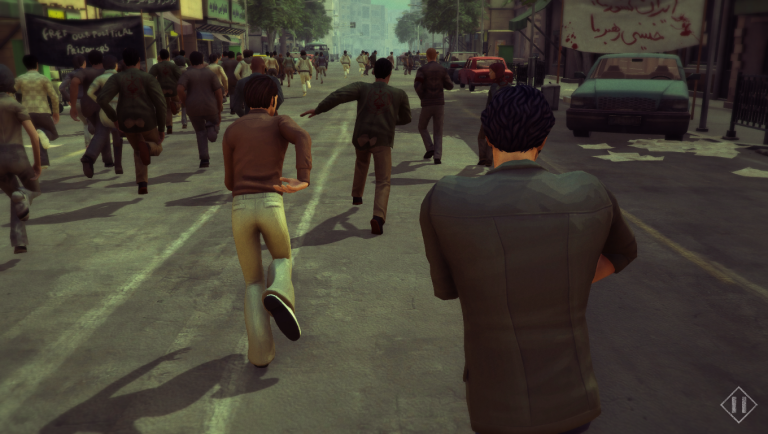
1979 Revolution: Black Friday (Review)
The indie game, Black Friday, is an ambitious attempt by Navid Khonsari and developers at INK Publishing to immerse their audience into a civil rebellion. Players take agency over the Character of Reza, son of an affluent conservative family, who must decide his path during the tipping point of the Iranian Revolution.
The premise is unconventional to western audiences and that’s the game’s allure. You assume the role of a photographer turned activist amidst a surging movement. Our character is influenced by family and friends who challenge his ideals of what’s right and wrong in a country undergoing transformation. Will he choose to abandon the camera for more violent forms of protest? Will he fight to defend others from violence? Do his photos communicate a message of his choosing, or will the message be chosen for him? Does he have any say in where the movement is heading?
From an analysis of the game’s mechanics, players find themselves largely stripped from being able to make decisions that allow much deviation in the game’s outcomes. The mechanics end up being at odds with the game designer’s intentions. To choose your own adventure. Revolution 1979: Black Friday promotes the ideal that in Iran during 1979 there were only two sides for an individual to choose. Support US allied dictator Mohammad Reza Shah Pahlavi, or support socialist endorsed Supreme Leader Ayatollah Ruhollah Khomeini. As an outsider to Islam, it’s difficult to know who would be better when choosing between brutal dictators and supreme leaders. Is there a difference between those two titles? Perhaps developers could have considered a third possible option: Escape.
There are several instances in the game where players are offered a choice of dialogue. Many times we are offered three types of similar answers framed with different attitudes. Our forth choice is to say nothing, and yet many times when that option is chosen our character is responded to like any other response. At what seems like crucial points in the game’s dialogue the option of silence is taken away entirely, and the player is left with three variations of the same answer. There is no option to abstain from the rebellion. You bought the ticket, and now you’re on the ride.
Quick time events are the height of action. Timed button presses follow the same sequence with every play through. We’re always ducking the same punch, or jumping over the same trashcan. Moving Reza through the streets of Tehran is like being on the guided track of some fun house roller coaster geared toward Islamic infotainment. It’s a bit slow. Players are asked to take pictures of events along the street, and the game’s photography mechanic involves scanning a needle as it swings like a pendulum across a light meter, while the frame moves in and out of focus. Like how real photographer’s use cameras, right?
When Reza takes a photo of something we can see real world equivalents to the Iranian Revolution along with captions meant to evoke empathy. One notable photo compared Muslim prayer in the street to the sit-ins held by blacks during the American Civil Rights movement. Another photo showed that the same booths propagating bootleg copies of pop albums were also valuable in disseminating the speeches of Khomeini. These factoids provide critical thinkers with more questions than facts. Is the Islamic theocratic takeover of Iran equivalent to American blacks protesting for the same level of service as their white counterparts? What does it mean to show Western Pop consumerism as the vehicle for Socialist ideals?
The photography mechanic is particularly flimsy and acts mainly as a device to spread information to the player, which is ironic because being a photographer, and spreading information to others is the main focus of Reza’s character. If the player were to realistically take agency over the character of a photographer, it would be so that the player could choose what information to spread as a photographer does. To the contrary, quality of the player’s photos and their ability to perform has little impact on the game’s story. One could play the game without voluntarily taking a single photo. In one scene where police arrive to disband a protest, Reza is asked to photograph the event. If the player refuses, a photo will be taken for them, allowing a string of actions to take place in the story where revolutionaries use your photos without your consent to promote their agenda.
There’s little skill to be developed and limited variations on what happens in the story, so are these features of an entertaining game with high replay-ability? Could it be that the main purpose of this game is to advertise the ideals presented to you? To get you to think like-minded when viewing “the cause”, no matter what choices they provide to you?
Reza is given different questions to answer in a conversation heading towards a single outcome. His perceived imprisonment becomes literal imprisonment, and he is destined by the writer’s of this game to become a martyr for the cause. The most important decision we get to make in this game’s story results in choosing how we get to die. Will it be in the hands of our interrogator, or by the hands of our own brother in the secret police. Neither outcome bodes well feelings, a sense of accomplishment, or an ideal of how to succeed moving forward. All of which are things people hope to see as outcomes of a revolution. Unfortunately the mob might not be the way to individual success.
TL;DR | Sometimes a video game is little more than a veiled narrative. “1979 Revolution: Black Friday” would accurately fit such a depiction featuring a special knack for propaganda. With such a political charge attached to the narrative and few outcomes for players, it’s difficult to deny a feeling of indoctrination throughout this game.